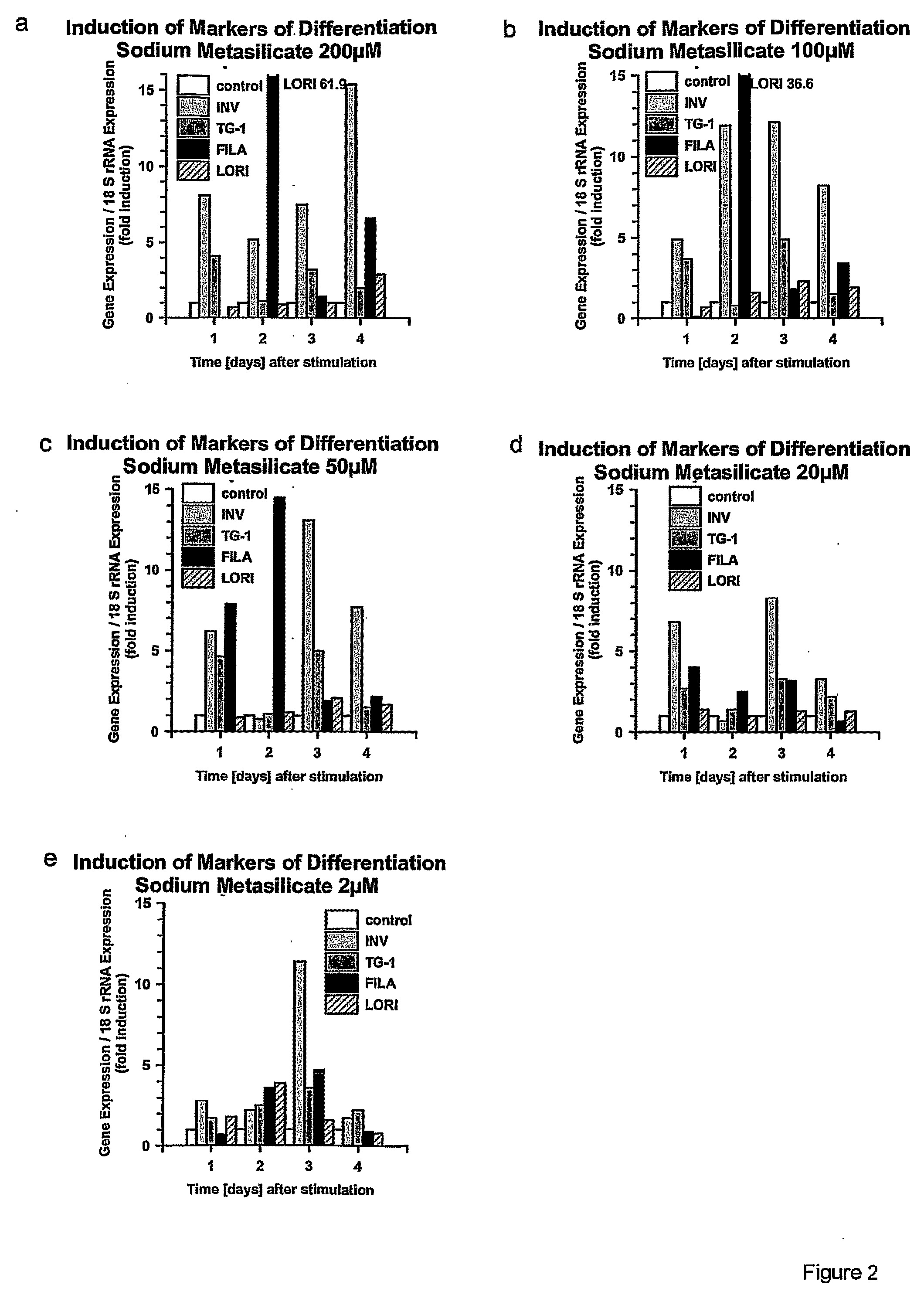Pharmeceutical and cosmetic use of silica
a technology of silica and cosmetics, applied in the field of cosmetics and cosmetically effective ingredients, can solve the problems of multiple deleterious effects in the epidermis and dermis, limited evidence of beneficial effects of individual components, and inability to inhibit photo-reduced up-regulation of mmps, etc., to achieve the effect of enhancing skin barrier function, reducing collagen 1a expression, and inhibiting photo-reduction up-regulation
- Summary
- Abstract
- Description
- Claims
- Application Information
AI Technical Summary
Benefits of technology
Problems solved by technology
Method used
Image
Examples
example 1
Characterisation of Silica Used in Experiments
[0051]Sample 1: precipitated silica mud from Svartsengi geothermal basin, dried without washing.
[0052]Sample 2: same source material, washed with water until conductance was below 500 μS / cm.
[0053]Sample 3: wet silica filter cake (same source as samples 1 and 2).
[0054]Specific surface area and porosity: adsorption and desorption isotherm for nitrogen at liquid nitrogen temperature were measured with Tristar 3000 from Micromeritics. Surface area and porosity are calculated with software provided with the instrument. Samples were ground and sieved prior to analysis.
[0055]Particle size distribution: Particle size was determined with Malvern Mastersizer 2000. The samples were suspended in distilled water and the concentration adjusted to the appropriate range for the instrument. In the analysis of the data it is assumed that refraction index for the particles is 1.45 and the adsorption 0.1.
Results:
[0056]
TABLE 1Surface characteristicsSample 1S...
example 2
Induction of Differentiation in Human Epidermal Keratinocytes by Silica Preparates
[0058]The effect of silica mud and sodium metasilicate on the differentiation markers Involucrin, transglutaminase-1, Filaggrin, and Loricrin in human epidermal keratinocytes has been assessed.
Material & Methods
[0059]Silica mud precipitate was obtained from a natural source (Blue Lagoon geothermal basin, Svartsengi, Iceland). Sodium metasilicate was obtained from Prof. Dr. G. Lehmann, Biochemistry, Regensburg University. As control a ceramide mix (10 μM) was used to induce the differentiation markers.
[0060]Long term cultured normal human epidermal keratinocytes, NHEK, prepared from neonatal foreskin are cultured in Keratinocyte SFM (Invitrogen™, Heidelberg, Germany) supplemented with bovine pituitary extract (Invitrogen, Heidelberg, Germany) and recombinant epidermal growth factor (Invitrogen, Heidelberg, Germany). Cells are propagated up to passage 2 or 3 at 37° C. and 5% CO2. For induction of differe...
example 3
Photoaging Inhibitory Effect of Silica
[0069]The photo-protective capacity of silica was assessed in UVA-irradiated human dermal fibroblasts. Induction of MMP-1 is a marker for skin aging. UVA-induced up-regulation of the cytokine IL-6 has previously been shown to be a prerequisite of UVA-induced MMP-1 induction.
[0070]Human dermal fibroblasts, HDF, prepared from neonatal foreskin are cultured in DMEM supplemented with 10% FBS in 5% CO2 for 4 days until they reached confluence as described (Vielhaber et al., 2006). For all studies, only early passage (<12) fibroblasts will be used to avoid changes in their original phenotype during subculture.
[0071]The fibroblasts are incubated with different amount of colloidal silica and subjected to UV light. Briefly, for UVA radiation the medium was replaced by phosphate buffered saline, lids were removed and cells were exposed to a dose of 30 J / cm2 UVA1 using a UVASUN 24,000 system (Sellas GmbH, Dr. Sellmeier Gevelsberg, Germany). The UVAL output...
PUM
 Login to View More
Login to View More Abstract
Description
Claims
Application Information
 Login to View More
Login to View More - R&D
- Intellectual Property
- Life Sciences
- Materials
- Tech Scout
- Unparalleled Data Quality
- Higher Quality Content
- 60% Fewer Hallucinations
Browse by: Latest US Patents, China's latest patents, Technical Efficacy Thesaurus, Application Domain, Technology Topic, Popular Technical Reports.
© 2025 PatSnap. All rights reserved.Legal|Privacy policy|Modern Slavery Act Transparency Statement|Sitemap|About US| Contact US: help@patsnap.com



